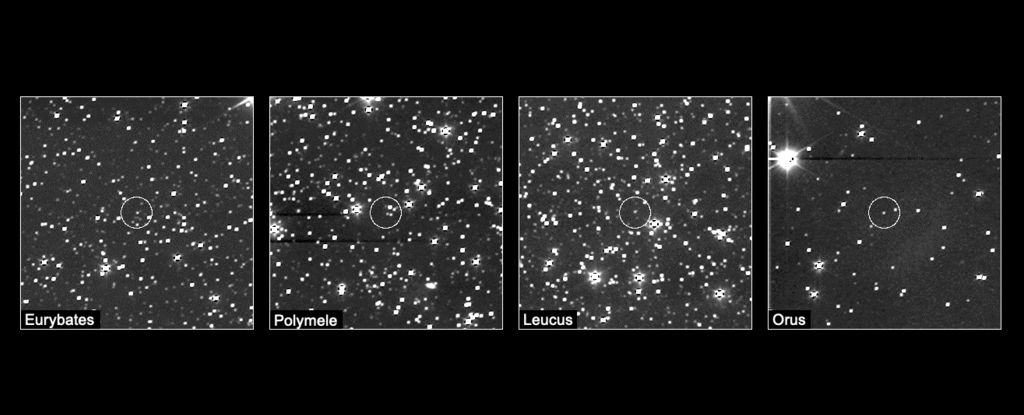A spacecraft quietly speeding its way through the Solar System has caught its first glimpses of the asteroids it was sent to investigate from a distance of hundreds of thousands of kilometers.
Launched in October 2021, NASA's Lucy probe heads the first-ever mission to study the asteroids attendant on Jupiter. Of the 11 objects it is scheduled to visit, the probe has already imaged four, providing us with timelapses of the asteroids Eurybates, Polymele, Leucus, and Orus.
The Trojan asteroids are a group of space rocks that share the orbit of Jupiter. They're divided into two populations that preceed and trail the giant planet on its journey around the Sun.
Asteroids tend to collect in those two positions of Jupiter's orbital path in what are known as Lagrangian points. These are pockets of gravitational stability created by an interaction between two bodies in an orbital system. In these pockets, the gravitational pulls of the two bodies – in this case, Jupiter and the Sun – balance perfectly with the centripetal force of an object within the Lagrangian to hold it in place.
Each two-body system has five Lagrangians; the two in which the Trojans gather are L4 and L5. Although the asteroids are all collectively known as Trojans, the group that sits in L4 are classified as Greeks, while the L5 asteroids are Trojans. You can see how they move with Jupiter in the animation below.
There are thousands of asteroids within the Trojan swarms, and they're thought to be made up of pristine materials that made the planets, in the early days of the Solar System. Lucy's mission is to fly by and closely study nine of them, from both the Greek and Trojan camps, as well as two asteroids in the Main Belt that sits between Jupiter and Mars, during its 12-year mission.
Fans of human evolution might recall the name Lucy also belongs to a certain fossil of an ancestral species called Australopithecus afarensis. Just as the hominid Lucy taught us a few things about the origins of Homo sapiens, scientists hope that the Lucy mission will tell us more about how the Solar System formed.
Eurybates, Polymele, Leucus, and Orus all belong to the Greek swarm, and Lucy will be visiting them in 2027 and 2028, sending the data it obtains back home to Earth. When these images were taken between March 25 and 27, the spacecraft was over 530 million kilometers (330 million miles) from some of its asteroid targets. That's more than three times the distance between Earth and the Sun.
Each target was viewed for a period of time: 6.5 hours for Eurybates, 2.5 hours for Polymele, 2 hours for Leucus and 10 hours for Orus. The resulting data will be combined with continuing observations as Lucy approaches, studying how these objects reflect sunlight in ways we can't see from here on Earth.
Lucy's first asteroid encounter is set to take place in November of this year, when it will fly by the Main Belt asteroid Dinkinesh (the Ethiopian name for Lucy), before swooping back to Earth for a gravity assist maneuver that will give it a boost back towards Jupiter's orbit.
It will fly by one more Main Belt asteroid, Donaldjohanson (named for the paleoanthropologist who discovered Lucy), on its way to the Greeks in April 2025, before finally making its historic encounter with Eurybates in August 2027.
